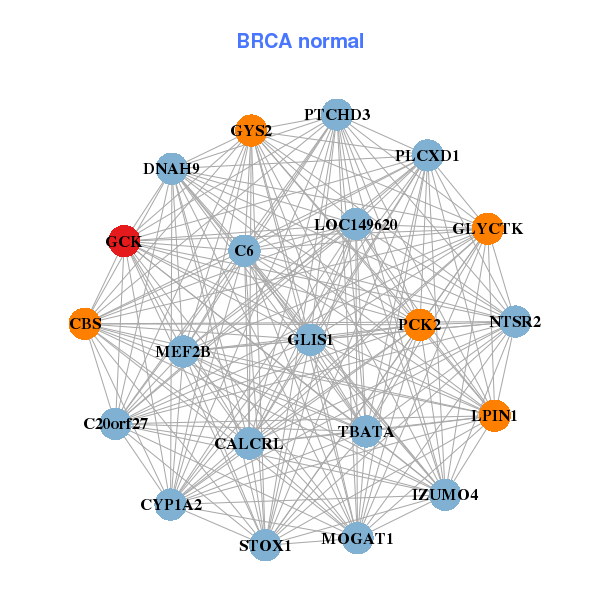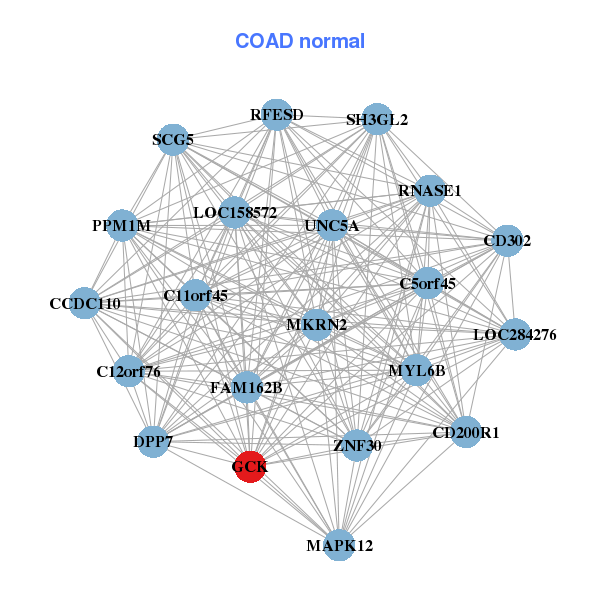|
|||||||||||||||||||||||||||||||||||||||||||||||||||||||||||||||||||||||||||||||||||||||||||||||||||||||||||||||||||||||||||||||||||||||||||||||||||||||||||||||||||||||||||||||||||||||||||||||||||||||||||||||||||||||||||||||||||||||||||||||||||||||||||||||||||||||||||||||||||||||||||||||||||||||||||||||||||||||||||||||||||||||||||||||||||||||||||||||||||||||||||||||||
| |
| Phenotypic Information (metabolism pathway, cancer, disease, phenome) |
| |
| |
| Gene-Gene Network Information: Co-Expression Network, Interacting Genes & KEGG |
| |
|
| Gene Summary for GCK |
| Basic gene info. | Gene symbol | GCK |
| Gene name | glucokinase (hexokinase 4) | |
| Synonyms | FGQTL3|GK|GLK|HHF3|HK4|HKIV|HXKP|LGLK|MODY2 | |
| Cytomap | UCSC genome browser: 7p15.3-p15.1 | |
| Genomic location | chr7 :44183869-44229022 | |
| Type of gene | protein-coding | |
| RefGenes | NM_000162.3, NM_033507.1,NM_033508.1, | |
| Ensembl id | ENSG00000106633 | |
| Description | ATP:D-hexose 6-phosphotransferaseHK IVglucokinasehexokinase D, pancreatic isozymehexokinase type IVhexokinase-4hexokinase-D | |
| Modification date | 20141222 | |
| dbXrefs | MIM : 138079 | |
| HGNC : HGNC | ||
| Ensembl : ENSG00000106633 | ||
| HPRD : 00680 | ||
| Vega : OTTHUMG00000022903 | ||
| Protein | UniProt: P35557 go to UniProt's Cross Reference DB Table | |
| Expression | CleanEX: HS_GCK | |
| BioGPS: 2645 | ||
| Gene Expression Atlas: ENSG00000106633 | ||
| The Human Protein Atlas: ENSG00000106633 | ||
| Pathway | NCI Pathway Interaction Database: GCK | |
| KEGG: GCK | ||
| REACTOME: GCK | ||
| ConsensusPathDB | ||
| Pathway Commons: GCK | ||
| Metabolism | MetaCyc: GCK | |
| HUMANCyc: GCK | ||
| Regulation | Ensembl's Regulation: ENSG00000106633 | |
| miRBase: chr7 :44,183,869-44,229,022 | ||
| TargetScan: NM_000162 | ||
| cisRED: ENSG00000106633 | ||
| Context | iHOP: GCK | |
| cancer metabolism search in PubMed: GCK | ||
| UCL Cancer Institute: GCK | ||
| Assigned class in ccmGDB | B - This gene belongs to cancer gene. | |
| Top |
| Phenotypic Information for GCK(metabolism pathway, cancer, disease, phenome) |
| Cancer | CGAP: GCK |
| Familial Cancer Database: GCK | |
| * This gene is included in those cancer gene databases. |
|
|
|
|
|
|
| |||||||||||||||||||||||||||||||||||||||||||||||||||||||||||||||||||||||||||||||||||||||||||||||||||||||||||||||||||||||||||||||||||||||||||||||||||||||||||||||||||||||||||||||||||||||||||||||||||||||||||||||||||||||||||||||||||||||||||||||||||||||||||||||||||||||||||||||||||||||||||||||||||||||||||||||||||||||||||||||||||||||||||||||||||||||||||||||||||||||||||
Oncogene 1 | Significant driver gene in | ||||||||||||||||||||||||||||||||||||||||||||||||||||||||||||||||||||||||||||||||||||||||||||||||||||||||||||||||||||||||||||||||||||||||||||||||||||||||||||||||||||||||||||||||||||||||||||||||||||||||||||||||||||||||||||||||||||||||||||||||||||||||||||||||||||||||||||||||||||||||||||||||||||||||||||||||||||||||||||||||||||||||||||||||||||||||||||||||||||||||||||||||
| cf) number; DB name 1 Oncogene; http://nar.oxfordjournals.org/content/35/suppl_1/D721.long, 2 Tumor Suppressor gene; https://bioinfo.uth.edu/TSGene/, 3 Cancer Gene Census; http://www.nature.com/nrc/journal/v4/n3/abs/nrc1299.html, 4 CancerGenes; http://nar.oxfordjournals.org/content/35/suppl_1/D721.long, 5 Network of Cancer Gene; http://ncg.kcl.ac.uk/index.php, 1Therapeutic Vulnerabilities in Cancer; http://cbio.mskcc.org/cancergenomics/statius/ |
| KEGG_GLYCOLYSIS_GLUCONEOGENESIS KEGG_GALACTOSE_METABOLISM KEGG_STARCH_AND_SUCROSE_METABOLISM KEGG_AMINO_SUGAR_AND_NUCLEOTIDE_SUGAR_METABOLISM REACTOME_METABOLISM_OF_CARBOHYDRATES | |
| OMIM | 125851; phenotype. 138079; gene. 602485; phenotype. 606391; phenotype. |
| Orphanet | 552; MODY syndrome. 79299; Hyperinsulinism due to glucokinase deficiency. 99885; Permanent neonatal diabetes mellitus. |
| Disease | KEGG Disease: GCK |
| MedGen: GCK (Human Medical Genetics with Condition) | |
| ClinVar: GCK | |
| Phenotype | MGI: GCK (International Mouse Phenotyping Consortium) |
| PhenomicDB: GCK | |
| Mutations for GCK |
| * Under tables are showing count per each tissue to give us broad intuition about tissue specific mutation patterns.You can go to the detailed page for each mutation database's web site. |
| - Statistics for Tissue and Mutation type | Top |
 |
| - For Inter-chromosomal Variations |
| There's no inter-chromosomal structural variation. |
| - For Intra-chromosomal Variations |
| * Intra-chromosomal variantions includes 'intrachromosomal amplicon to amplicon', 'intrachromosomal amplicon to non-amplified dna', 'intrachromosomal deletion', 'intrachromosomal fold-back inversion', 'intrachromosomal inversion', 'intrachromosomal tandem duplication', 'Intrachromosomal unknown type', 'intrachromosomal with inverted orientation', 'intrachromosomal with non-inverted orientation'. |
 |
| Sample | Symbol_a | Chr_a | Start_a | End_a | Symbol_b | Chr_b | Start_b | End_b |
| ovary | GCK | chr7 | 44200584 | 44200604 | GCK | chr7 | 44199791 | 44199811 |
| pancreas | GCK | chr7 | 44210276 | 44210296 | chr7 | 41067267 | 41067287 |
| cf) Tissue number; Tissue name (1;Breast, 2;Central_nervous_system, 3;Haematopoietic_and_lymphoid_tissue, 4;Large_intestine, 5;Liver, 6;Lung, 7;Ovary, 8;Pancreas, 9;Prostate, 10;Skin, 11;Soft_tissue, 12;Upper_aerodigestive_tract) |
| * From mRNA Sanger sequences, Chitars2.0 arranged chimeric transcripts. This table shows GCK related fusion information. |
| ID | Head Gene | Tail Gene | Accession | Gene_a | qStart_a | qEnd_a | Chromosome_a | tStart_a | tEnd_a | Gene_a | qStart_a | qEnd_a | Chromosome_a | tStart_a | tEnd_a |
| BF885201 | GCK | 143 | 162 | 7 | 44184199 | 44184218 | FRA10AC1 | 158 | 209 | 10 | 95450597 | 95450648 | |
| Top |
| Mutation type/ Tissue ID | brca | cns | cerv | endome | haematopo | kidn | Lintest | liver | lung | ns | ovary | pancre | prost | skin | stoma | thyro | urina | |||
| Total # sample | 1 | |||||||||||||||||||
| GAIN (# sample) | 1 | |||||||||||||||||||
| LOSS (# sample) |
| cf) Tissue ID; Tissue type (1; Breast, 2; Central_nervous_system, 3; Cervix, 4; Endometrium, 5; Haematopoietic_and_lymphoid_tissue, 6; Kidney, 7; Large_intestine, 8; Liver, 9; Lung, 10; NS, 11; Ovary, 12; Pancreas, 13; Prostate, 14; Skin, 15; Stomach, 16; Thyroid, 17; Urinary_tract) |
| Top |
|
 |
| Top |
| Stat. for Non-Synonymous SNVs (# total SNVs=31) | (# total SNVs=31) |
 |  |
(# total SNVs=0) | (# total SNVs=0) |
| Top |
| * When you move the cursor on each content, you can see more deailed mutation information on the Tooltip. Those are primary_site,primary_histology,mutation(aa),pubmedID. |
| GRCh37 position | Mutation(aa) | Unique sampleID count |
| chr7:44190669-44190669 | p.F124F | 4 |
| chr7:44190569-44190569 | p.E158K | 3 |
| chr7:44189604-44189604 | p.V182V | 3 |
| chr7:44193018-44193018 | p.L31L | 3 |
| chr7:44186118-44186118 | p.S322S | 2 |
| chr7:44190560-44190560 | p.D161N | 2 |
| chr7:44198715-44198715 | p.A2V | 2 |
| chr7:44189575-44189575 | p.R192Q | 2 |
| chr7:44189372-44189372 | p.V223V | 2 |
| chr7:44186153-44186153 | p.V311M | 2 |
| Top |
|
 |
| Point Mutation/ Tissue ID | 1 | 2 | 3 | 4 | 5 | 6 | 7 | 8 | 9 | 10 | 11 | 12 | 13 | 14 | 15 | 16 | 17 | 18 | 19 | 20 |
| # sample | 3 | 3 | 14 | 2 | 5 | 1 | 10 | 8 | 1 | 19 | 7 | 5 | ||||||||
| # mutation | 3 | 3 | 14 | 2 | 5 | 1 | 10 | 9 | 1 | 24 | 8 | 7 | ||||||||
| nonsynonymous SNV | 2 | 5 | 1 | 2 | 4 | 7 | 1 | 17 | 4 | 3 | ||||||||||
| synonymous SNV | 3 | 1 | 9 | 1 | 3 | 1 | 6 | 2 | 7 | 4 | 4 |
| cf) Tissue ID; Tissue type (1; BLCA[Bladder Urothelial Carcinoma], 2; BRCA[Breast invasive carcinoma], 3; CESC[Cervical squamous cell carcinoma and endocervical adenocarcinoma], 4; COAD[Colon adenocarcinoma], 5; GBM[Glioblastoma multiforme], 6; Glioma Low Grade, 7; HNSC[Head and Neck squamous cell carcinoma], 8; KICH[Kidney Chromophobe], 9; KIRC[Kidney renal clear cell carcinoma], 10; KIRP[Kidney renal papillary cell carcinoma], 11; LAML[Acute Myeloid Leukemia], 12; LUAD[Lung adenocarcinoma], 13; LUSC[Lung squamous cell carcinoma], 14; OV[Ovarian serous cystadenocarcinoma ], 15; PAAD[Pancreatic adenocarcinoma], 16; PRAD[Prostate adenocarcinoma], 17; SKCM[Skin Cutaneous Melanoma], 18:STAD[Stomach adenocarcinoma], 19:THCA[Thyroid carcinoma], 20:UCEC[Uterine Corpus Endometrial Carcinoma]) |
| Top |
| * We represented just top 10 SNVs. When you move the cursor on each content, you can see more deailed mutation information on the Tooltip. Those are primary_site, primary_histology, mutation(aa), pubmedID. |
| Genomic Position | Mutation(aa) | Unique sampleID count |
| chr7:44193018 | p.F123F,GCK | 3 |
| chr7:44190669 | p.L30L,GCK | 3 |
| chr7:44191894 | p.S321S,GCK | 2 |
| chr7:44189392 | p.E216K,GCK | 2 |
| chr7:44189604 | p.D113D,GCK | 2 |
| chr7:44198715 | p.V181V,GCK | 2 |
| chr7:44186118 | p.A2V | 2 |
| chr7:44185241 | p.P59P,GCK | 1 |
| chr7:44189583 | p.E9D | 1 |
| chr7:44193036 | p.C220C,GCK | 1 |
| * Copy number data were extracted from TCGA using R package TCGA-Assembler. The URLs of all public data files on TCGA DCC data server were gathered on Jan-05-2015. Function ProcessCNAData in TCGA-Assembler package was used to obtain gene-level copy number value which is calculated as the average copy number of the genomic region of a gene. |
 |
| cf) Tissue ID[Tissue type]: BLCA[Bladder Urothelial Carcinoma], BRCA[Breast invasive carcinoma], CESC[Cervical squamous cell carcinoma and endocervical adenocarcinoma], COAD[Colon adenocarcinoma], GBM[Glioblastoma multiforme], Glioma Low Grade, HNSC[Head and Neck squamous cell carcinoma], KICH[Kidney Chromophobe], KIRC[Kidney renal clear cell carcinoma], KIRP[Kidney renal papillary cell carcinoma], LAML[Acute Myeloid Leukemia], LUAD[Lung adenocarcinoma], LUSC[Lung squamous cell carcinoma], OV[Ovarian serous cystadenocarcinoma ], PAAD[Pancreatic adenocarcinoma], PRAD[Prostate adenocarcinoma], SKCM[Skin Cutaneous Melanoma], STAD[Stomach adenocarcinoma], THCA[Thyroid carcinoma], UCEC[Uterine Corpus Endometrial Carcinoma] |
| Top |
| Gene Expression for GCK |
| * CCLE gene expression data were extracted from CCLE_Expression_Entrez_2012-10-18.res: Gene-centric RMA-normalized mRNA expression data. |
 |
| * Normalized gene expression data of RNASeqV2 was extracted from TCGA using R package TCGA-Assembler. The URLs of all public data files on TCGA DCC data server were gathered at Jan-05-2015. Only eight cancer types have enough normal control samples for differential expression analysis. (t test, adjusted p<0.05 (using Benjamini-Hochberg FDR)) |
 |
| Top |
| * This plots show the correlation between CNV and gene expression. |
: Open all plots for all cancer types
 |
|
 |
|
| Top |
| Gene-Gene Network Information |
| * Co-Expression network figures were drawn using R package igraph. Only the top 20 genes with the highest correlations were shown. Red circle: input gene, orange circle: cell metabolism gene, sky circle: other gene |
: Open all plots for all cancer types
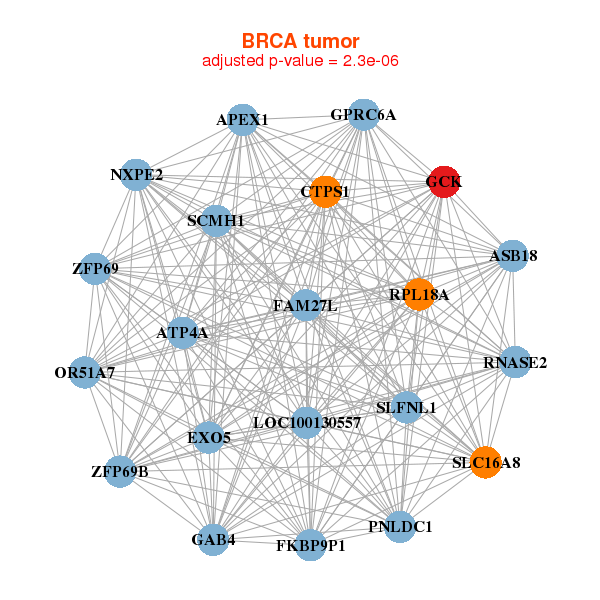 |
| ||||
| APCS,APOA1,APOA2,APOA4,APOB,APOC3,C3P1, C8A,C9,CREB3L3,CRP,F2,FABP1,FGF23, GCKR,HP,ITIH3,MT1B,PLG,SERPINA7,SULT2A1 | BMP1,C14orf177,C6,C7,CETP,CTSL,FLVCR2, GCKR,GPR64,HMOX1,HTRA3,INSL4,KIR3DP1,MAPK11, OR2AG1,OR8D1,RHOXF2B,SCARNA20,SNORA19,SPATA8,TMEM114 | ||||
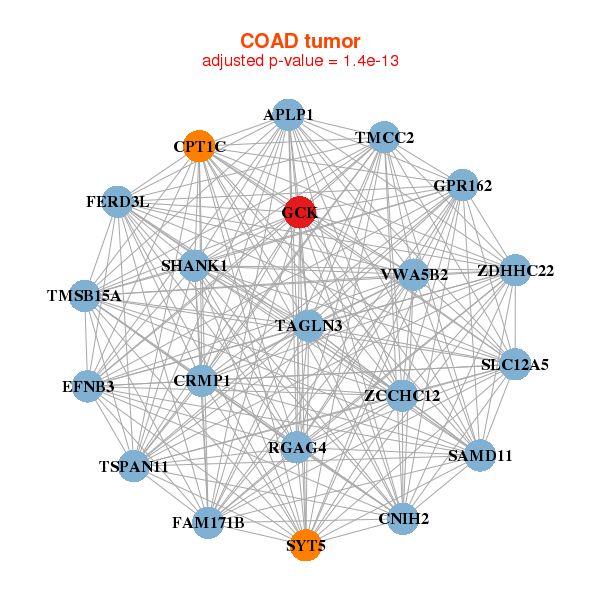 |
| ||||
| ADIPOR2,ANKRD2,C12orf5,CACNA1C,CHRNA6,DCP1B,FBXL14, FKBP4,FOXM1,GCKR,GPR139,MEGF11,NKX6-3,OR9K2, PARP11,PPY,TEAD4,TMEM132B,TMEM173,TTTY6B,TULP3 | AFP,APC,CA3,DNAJB3,FAM66E,GCKR,GOLGA6L1, IQUB,CEP104,LOC100128573,LINC01312,MGC45800,NHLH1,OGDH, RIPPLY1,SENP2,SGMS2,SNRK,ST7-OT4,TMEM86B,UGT1A1 |
| * Co-Expression network figures were drawn using R package igraph. Only the top 20 genes with the highest correlations were shown. Red circle: input gene, orange circle: cell metabolism gene, sky circle: other gene |
: Open all plots for all cancer types
| Top |
: Open all interacting genes' information including KEGG pathway for all interacting genes from DAVID
| Top |
| Pharmacological Information for GCK |
| DB Category | DB Name | DB's ID and Url link |
| Chemistry | BindingDB | P35557; -. |
| Chemistry | ChEMBL | CHEMBL3820; -. |
| Organism-specific databases | PharmGKB | PA28610; -. |
| Organism-specific databases | CTD | 2645; -. |
| * Gene Centered Interaction Network. |
 |
| * Drug Centered Interaction Network. |
| DrugBank ID | Target Name | Drug Groups | Generic Name | Drug Centered Network | Drug Structure |
| DB02379 | glucokinase (hexokinase 4) | experimental | Beta-D-Glucose | 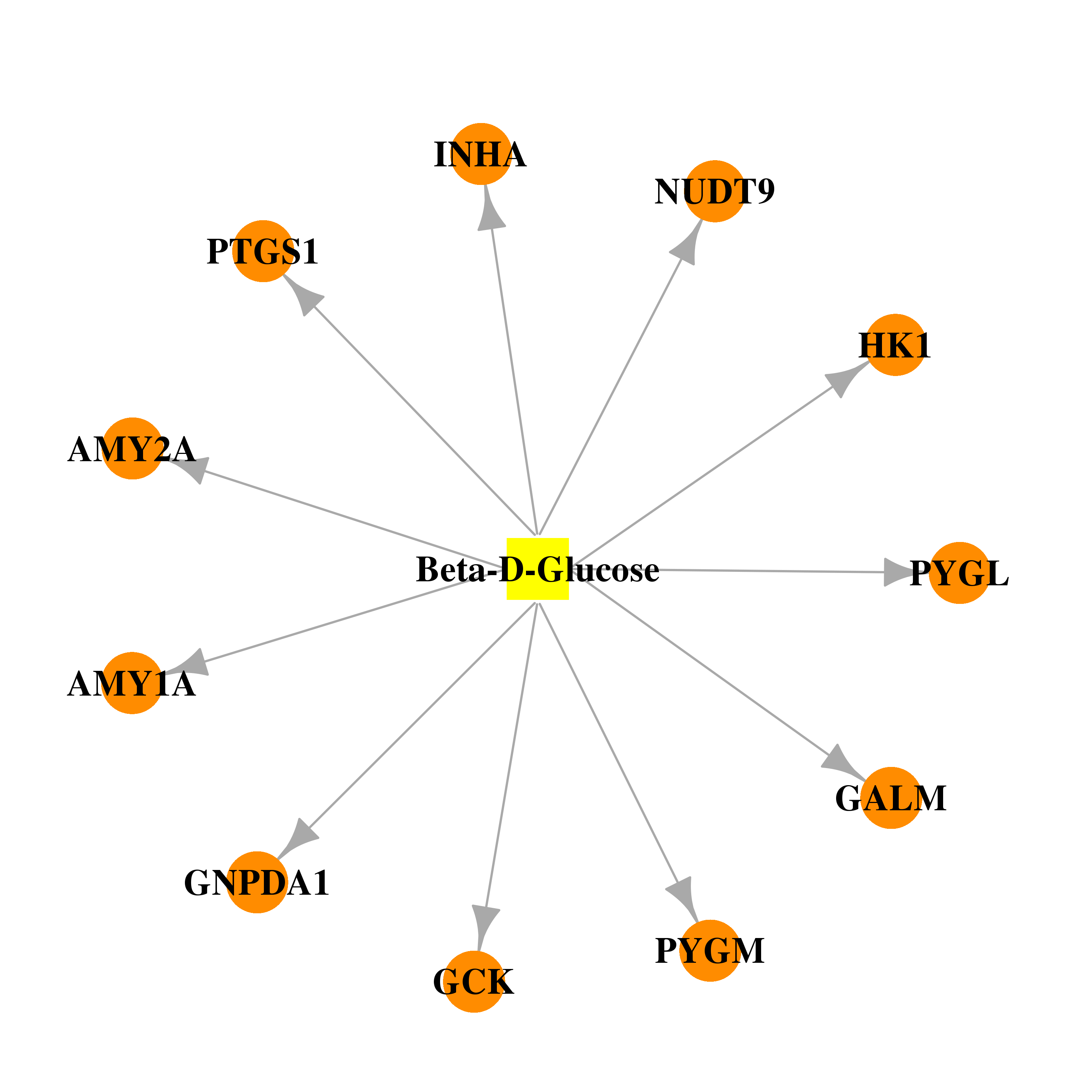 | 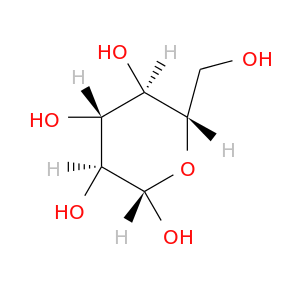 |
| DB07358 | glucokinase (hexokinase 4) | experimental | 2-amino-N-(4-methyl-1,3-thiazol-2-yl)-5-[(4-methyl-4H-1,2,4-triazol-3-yl)sulfanyl]benzamide | 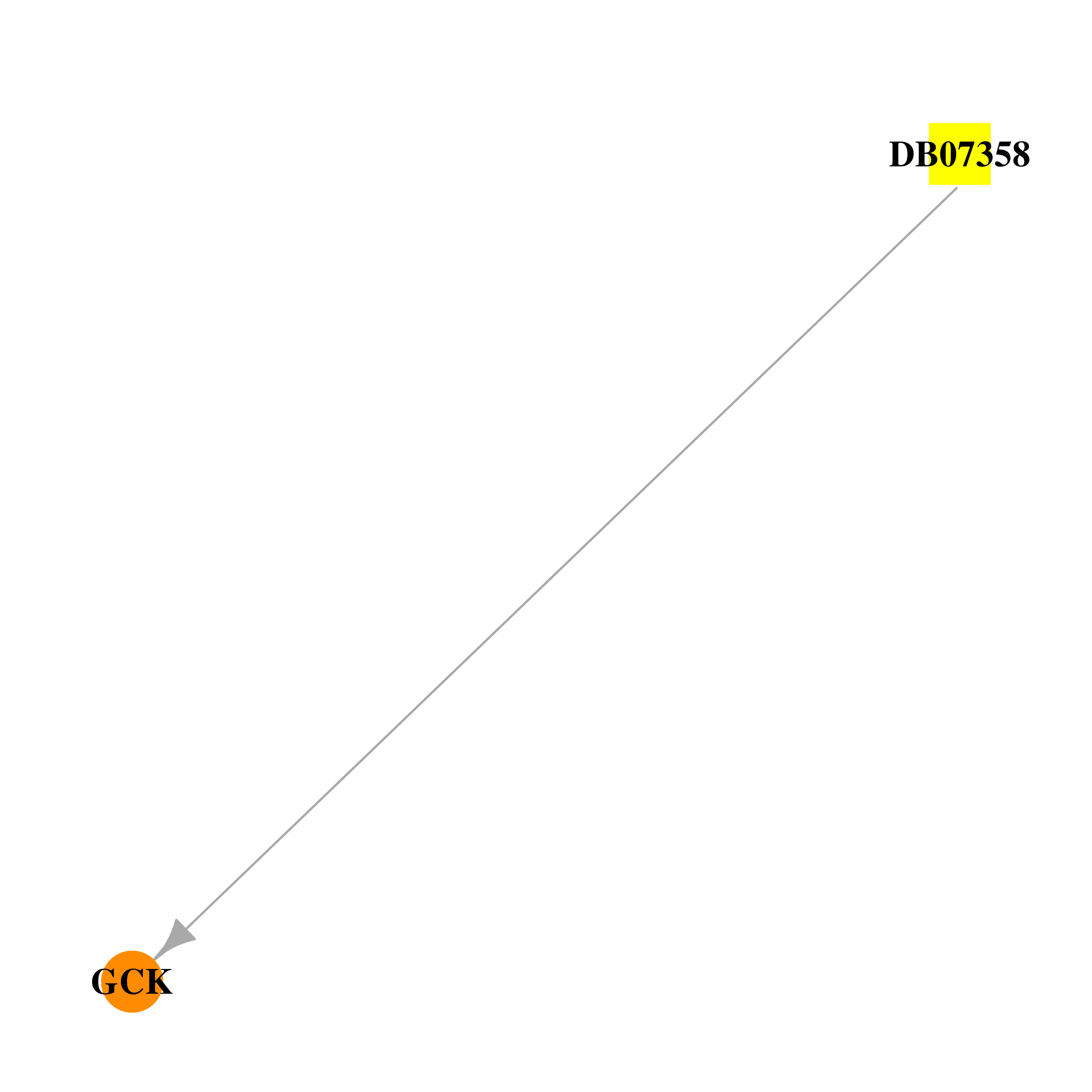 | 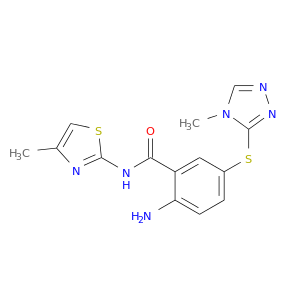 |
| DB07359 | glucokinase (hexokinase 4) | experimental | 3-[(4-fluorophenyl)sulfanyl]-N-(4-methyl-1,3-thiazol-2-yl)-6-[(4-methyl-4H-1,2,4-triazol-3-yl)sulfanyl]pyridine-2-carboxamide | 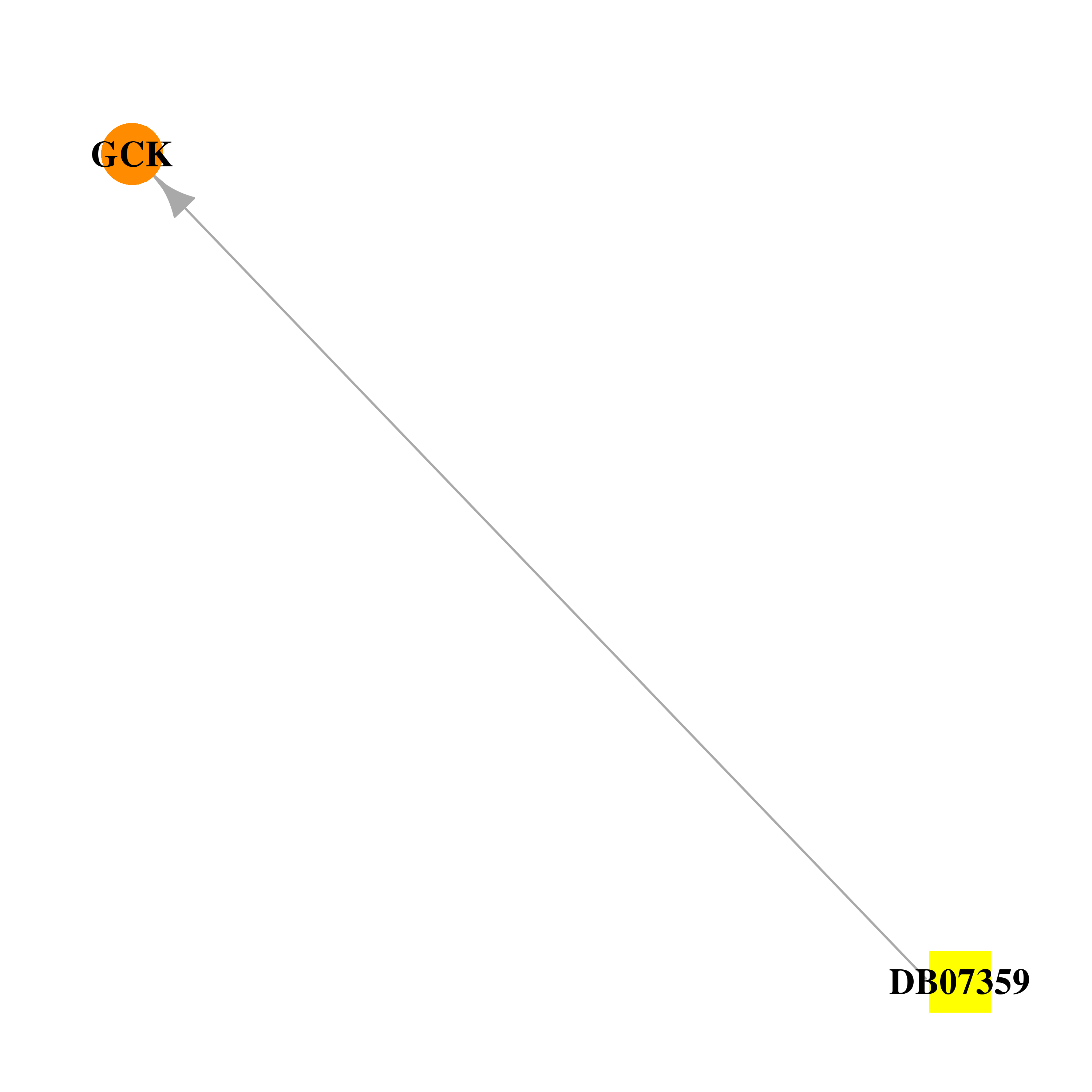 | 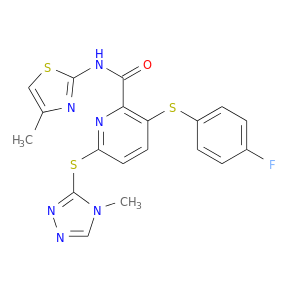 |
| DB08118 | glucokinase (hexokinase 4) | experimental | 2-(methylamino)-N-(4-methyl-1,3-thiazol-2-yl)-5-[(4-methyl-4H-1,2,4-triazol-3-yl)sulfanyl]benzamide | 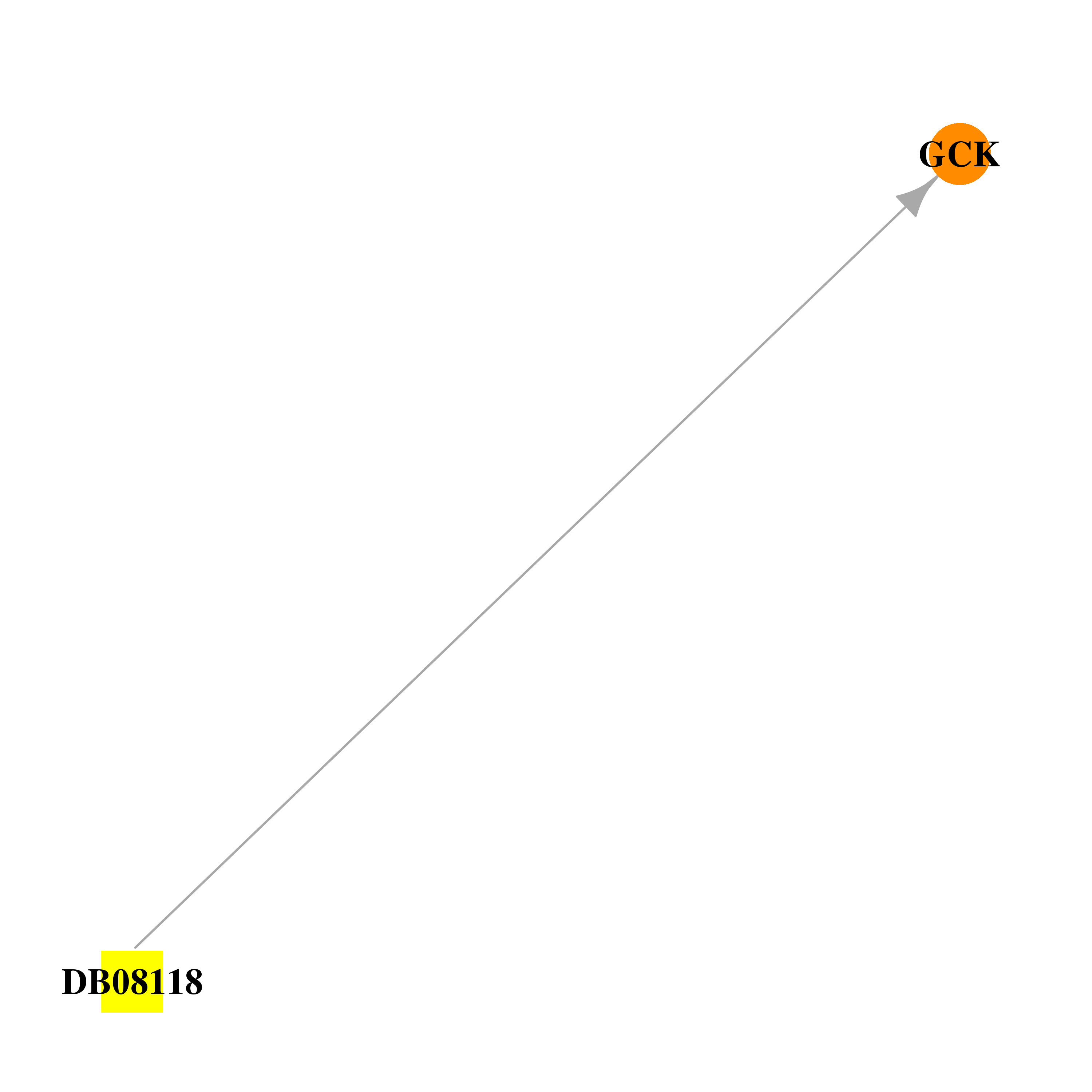 | 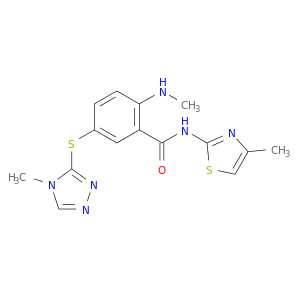 |
| DB08210 | glucokinase (hexokinase 4) | experimental | 2-AMINO-4-FLUORO-5-[(1-METHYL-1H-IMIDAZOL-2-YL)SULFANYL]-N-(1,3-THIAZOL-2-YL)BENZAMIDE | 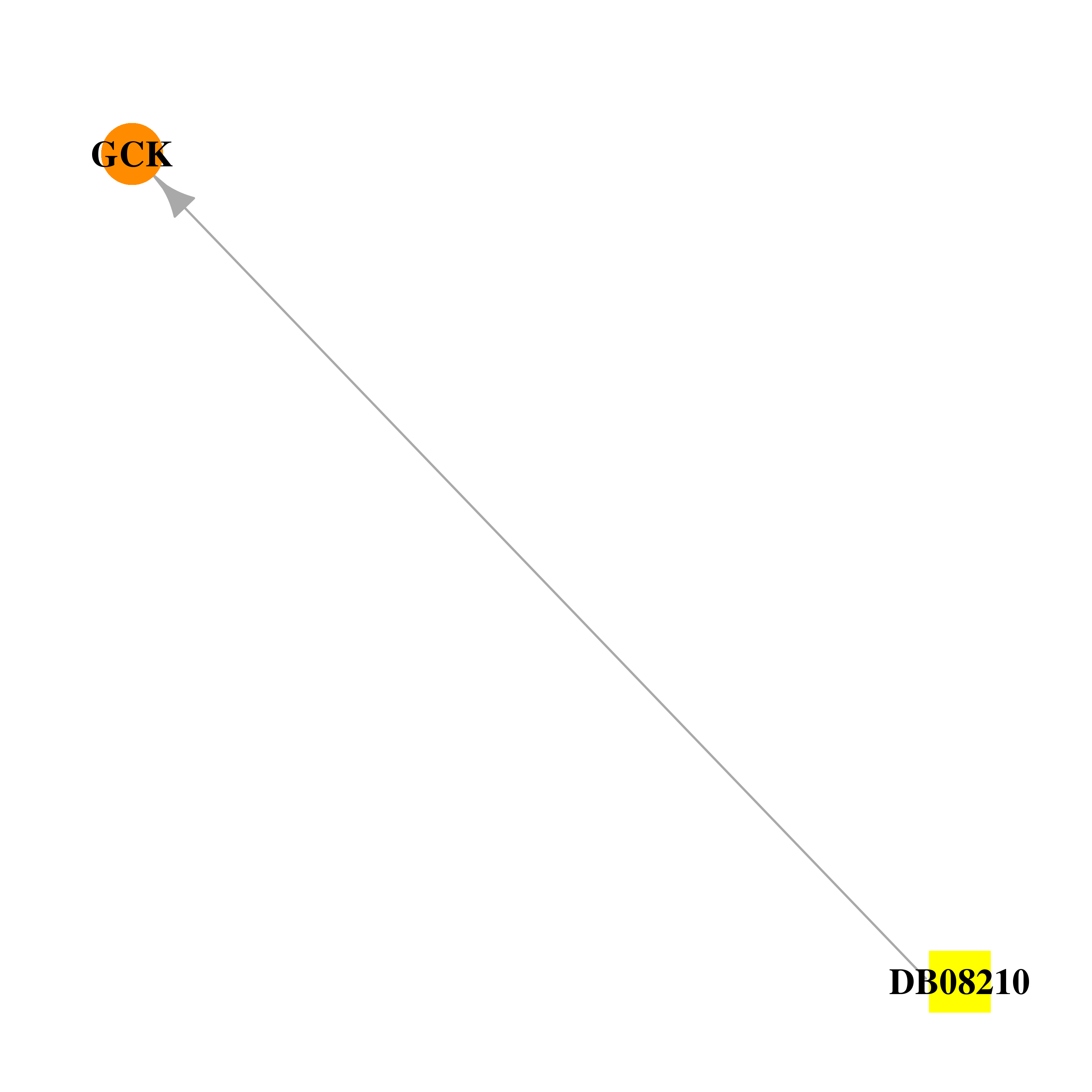 |  |
| Top |
| Cross referenced IDs for GCK |
| * We obtained these cross-references from Uniprot database. It covers 150 different DBs, 18 categories. http://www.uniprot.org/help/cross_references_section |
: Open all cross reference information
|
Copyright © 2016-Present - The Univsersity of Texas Health Science Center at Houston @ |








